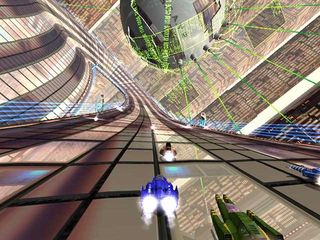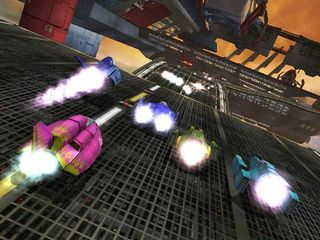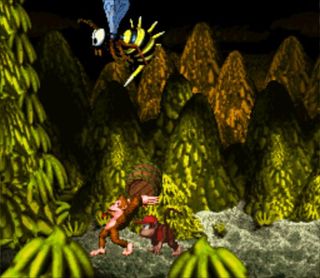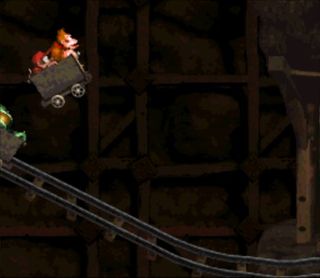The Top 7… Nintendo games not made by Nintendo
Everything gets better with cooperation

How it came about: Once Sega dropped out of the console race in 2001, it quickly began publishing titles for all the other platforms, including Super Monkey Ball, a launch title for the Gamecube. Soon enough SMB developer Amusement Vision was tapped by Nintendo to make a new F-Zero title not only for the Cube but the new Gamecube-based Triforce arcade board co-developed by Sega, Nintendo and Namco. While Namco made an adequate Star Fox title, Sega and Amusement Vision made one of the best racing games of last generation.

Why it was great: F-Zero GX/AX boasted impressive graphics that even today put most Wii games to shame. It had some of the most intricate, well-designed courses in racing history and we recently named it thesecond fastest game of all time. And let’s not even get into thelovably cheesy soundtrack. It didn’t hold your hand either, as GX was notorious for some really punishing courses, an incredibly steep learning curve and one of the most punishing story modes around.

Those that mastered the game hold it in high esteem and F-Zero GX is remembered very well. However, turns out Nintendo, and Shigeru Miyamoto in particular, weren’t fans of game, which may explain why we’ve yet to see a sequel. In 2006 Miyamoto said in anEntertainment Weekly interview, “In the past we've worked with some outside development houses on titles like F-Zero and Star Fox — and let me just say that we were disappointed with the results.” Seriously? What’s the matter, not enough blue koopa shells?

How it came about: Founded in the early ‘80s, Rare had been a very productive developer during the NES days, making Battletoads, Snake Rattle and Roll, and more licensed games than you can shake a money stick at. In the early ‘90s, as fancy CG graphics were becoming all the rage, the British company found a way to create 3D, polygonal, pre-rendered characters on the SNES, something many thought wouldn’t be possible on a home system until the next console cycle. Nintendo was impressed and gave Rare the keys to their oldest franchise, and we ended up with Donkey Kong Country.

Why it was great: Some may call us graphics whores now, but if you weren’t there at the time, you’ve no idea how great this looked. As game magazines showed off what the Saturn and PlayStation might be able to pull off, here was a SNES game in 1994 that was already doing it. As players took Donkey and Diddy Kong through the lovely yet dangerous jungles, players were treated to tons of visual flourishes, be it in mine cart levels, animal assists, or just listening to old Cranky Kong talk about the good old days.

That’s not to say it was all looks, as DKC had its own spectacularly fun style of platforming action, as well as some funny dialogue and a truly memorable soundtrack. It may not have been the easiest game, but that didn’t stop it from being one of the best-selling titles of all time, shifting more than 8 million copies total. Donkey Kong Counrty and its two sequels kept the SNES relevant until its end, despite newer, more powerful challengers. It’s no wonder that Nintendo quickly became part owners of Rare, which they had a stake in until selling it to Microsoft in 2002.

How it came about: Developer Hal Laboratory barely counts as a third party these days. It’s made games exclusively for Nintendo systems for decades now, and created franchise superstar Kirby. And their former President, Satoru Iwata, now runs Nintendo. Despite all this, when HAL employee and Kirbyco-creator Masahiro Sakurai wanted to make a four-player fighting game for the N64, there was some doubt it would be popular. Even once the devs were given permission by Nintendo to have the fighter include nearly every major Nintendo star, some doubted that game’s chance for success outside Japan. How wrong they were.
Sign up to the 12DOVE Newsletter
Weekly digests, tales from the communities you love, and more

Why it was great: The original Super Smash Bros seems like such an obvious idea, it’s amazing that nothing like it had really happened before. Until that point Nintendo’s many franchises had been pretty separate, but SSB brought them all together in a one incredibly frantic brawler. Dream matches like Mario vs Link, or Pikachu vs Samus were played out over and over in levels slathered in Nintendo love and nostalgia.

Fighting game purists may complain that SSB is a cheap, shallow affair that has no right being called a fighter, but the fans know better. The cheapness, the insanity, the unbalanced nature of the fights, all of it adds to the total chaotic pleasure of the whole thing. SSB has become one of Nintendo’s most successful franchises, and thankfully they haven’t milked it to death like Mario Party. Of the two sequels released in the last decade, both added tons more of what Nintendo fanboys love, making Super Smash Bros fans some of the most dedicated in the world.
Henry Gilbert is a former 12DOVE Editor, having spent seven years at the site helping to navigate our readers through the PS3 and Xbox 360 generation. Henry is now following another passion of his besides video games, working as the producer and podcast cohost of the popular Talking Simpsons and What a Cartoon podcasts.
Most Popular









